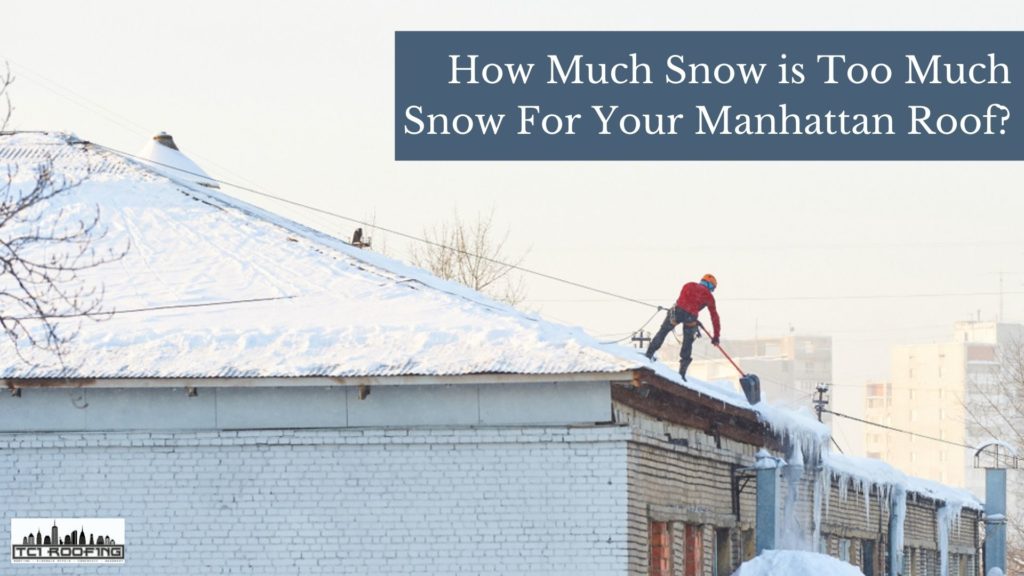How much snow is too much snow for Manhattan roofs? With today’s warmer temperatures, Manhattan homeowners wonder how to recover from the long winter and high snow levels. We all know that even a little bit of snow can bring out the worst in people, but it seems like we’ve been getting more than our fair share this year. So it’s time to find out: How much snow is too much for Manhattan, New York City roofs?
Figure How Much Weight your Roof can Support
Figure out the maximum weight that your roof can withstand. For example, most roofs can tolerate snowfall of 20 pounds per square foot.
Calculate the Weight of the Snow on your Roof
Calculate the weight of the snow load that has accumulated on your roof. Ten inches of fresh snow weighs roughly five pounds per square foot, so your roof can probably withstand four feet of snow. On the other hand, Packed snow is heavier: two feet or more of old snow is enough to surpass weight restrictions. The combined weight of old and new snow can easily exceed the load capacity. A roof may be collapsed by just two feet of each. Don’t forget to factor in ice. An inch of ice weighs the same as a foot of fresh snow.
Remove Excess Snow and Ice
Remove any snow or ice that has accumulated. This entails a clearing rate of more than 20 pounds per square foot. It’s best to use a snow rake with a lengthy extension arm. Alternatively, you might hire a professional to clear the snow and melting ice for you.
Look for Signs of a Stressed Roof
Look for signs that your roof is under stress. An overstressed roof will show indicators such as sagging ceiling tiles, sprinkler lines, popping or creaking noises, jammed doors, and windows, broken walls, or a leaky roof.
How Much Snow is Too Much Snow on a Roof?
When it comes to the quantity of snow that your roof can bear, most Manhattan roofing specialists can give you a good rule of thumb. The amount of snow that accumulates isn’t measured in inches; it’s measured in weight. Light and fluffy snow weigh less than heavy and dense snow, while packed snow weighs more than freshly fallen snow. As a result, most residential roofs can support snow loads of up to 20 pounds per square foot. Because a roof replacement is costly due to a snow damage in a Manhattan roof, keep an eye on the snow accumulation on your roof whenever it snows.
Can Snow Be Too Heavy for Roof?
According to the Insurance Institute for Business and Home Safety, most residential roofs in good shape can support 20 pounds per square foot of snow. Use the following guidelines to assess when the weight of the snow on your roof is reaching this limit:
- Freshly fallen snow: Weighs about 20 pounds per square foot (about four feet).
- Old, Packed Snow: Two feet of old, packed snow weighs approximately 20 pounds per square foot.
- Mixed new and old snow: Two to three feet of new and old snow equals 20 pounds per square foot.
Keep in mind when assessing your roof that flat roofs are more vulnerable to roof collapse due to the whole combined snow weight. This is because melt ice on flat roofs has a larger probability of refreezing before running off than it would on sloped roofs. Therefore, if your property has a flat roof, remove snow more frequently to avoid major structural damage.
How Much Snow Should you Take off your Roof?
After every 6 inches of snowfall, it’s a good idea to get your roof cleared. Ice dams are far less likely to form if you don’t let too much snow pile up on your roof, and you won’t have to worry about a roof cave-in.
When the snow on your roof accumulates quicker than it melts, you must manually remove it. Use the following safety precautions to protect yourself and your roof if you want to clear the snow manually:
- Never attempt to clear snow by yourself.
- To avoid bodily injury, remove the snow using a telescopic roof rake while standing on the ground.
- First, clear the snow and icicles from the roof’s edges. This is sometimes all that is required for the rest of the accumulated snow to slide away.
- If you need to use a ladder, ensure it’s in good working order and isn’t iced over. Before climbing up, firmly plant it in a snowdrift.
- When on your roof, always wear a safety harness. To protect yourself from serious falls, make sure the harness is fastened to a strong anchor point.
- When cleaning snow off your roof, use plastic shovels rather than metal equipment to shovel snow, as metal tools can damage your roofing material and cause structural problems.
Is it Bad to Have Snow on your Manhattan Roof?
Snow accumulation on your roof can cause severe water damage, resulting in roof repair expenses of roughly $2,386 on average. Flat roofs are especially vulnerable because the snow cannot roll off, forcing the pile to build and become heavier.
Call for a local roofing services in Manhattan for assistance if you are concerned about the snow on your roof or if you are experiencing storm damage due to the heavy snowfall.
Thoughts
Staying on top of roof snow removal will go a long way toward preventing roof collapse and leaks. Unfortunately, winter snowstorms have a habit of dumping far more snow than your roof can manage all at once. Call TCI Manhattan Roofing Repair Services NYC for prompt and effective residential water damage restoration services if you wake up to an unexpected snowfall and a leaking roof. Our staff will devise a complete restoration strategy and work quickly to return your house to normal as soon as possible, allowing you to resume enjoying the holiday season.

